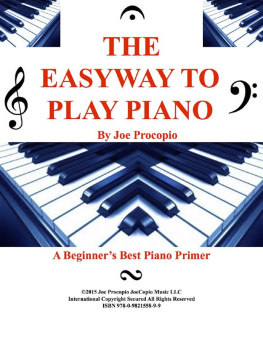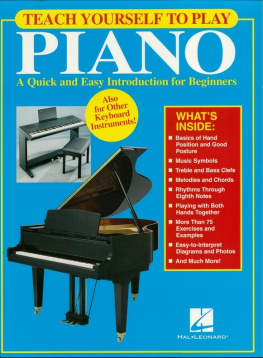Son - Basic Piano
Here you can read online Son - Basic Piano full text of the book (entire story) in english for free. Download pdf and epub, get meaning, cover and reviews about this ebook. year: 2015, publisher: A Una Voz, genre: Children. Description of the work, (preface) as well as reviews are available. Best literature library LitArk.com created for fans of good reading and offers a wide selection of genres:
Romance novel
Science fiction
Adventure
Detective
Science
History
Home and family
Prose
Art
Politics
Computer
Non-fiction
Religion
Business
Children
Humor
Choose a favorite category and find really read worthwhile books. Enjoy immersion in the world of imagination, feel the emotions of the characters or learn something new for yourself, make an fascinating discovery.
Basic Piano: summary, description and annotation
We offer to read an annotation, description, summary or preface (depends on what the author of the book "Basic Piano" wrote himself). If you haven't found the necessary information about the book — write in the comments, we will try to find it.
Son: author's other books
Who wrote Basic Piano? Find out the surname, the name of the author of the book and a list of all author's works by series.
Basic Piano — read online for free the complete book (whole text) full work
Below is the text of the book, divided by pages. System saving the place of the last page read, allows you to conveniently read the book "Basic Piano" online for free, without having to search again every time where you left off. Put a bookmark, and you can go to the page where you finished reading at any time.
Font size:
Interval:
Bookmark:
Basic Piano - 40 exercises - 72 Chord positions - 9 different accompaniment rhythms - 11 basic lessons - Audio CD (available thru internet connection) About this Method The following method is a careful compilation of concepts and basic techniques to learn how to play instruments. Complete series include 3 levels for the piano player and other instruments. This method will guide the student to understand the most important concepts of music applied to their area of study or instrument. The e-book transcription includes minimal modification to the original method, so the same tools that has been successfully applied to hundreds of students in our classes will be available around the world. About A Una Voz A Una Voz is a non profit organization, we believe in music as a powerful tool to transmit new values for a modern society. For further information visit www.aunavoz.net
Content - Previous concepts - 1.Basic fingering - 2. Eighth notes - 3. Accidental notes - 4. Major scales - 5. Major chords - 6. Minor chords - 7.
Chord progressions - 8. Rhythm patterns - 9. Left hand patterns - 10. Syncopated rhythms - 11. Accompaniment Examples Previous Concepts This first part covers the basics you need to know about the piano or keyboard, and some very important musical notation concepts.
The common string of these notes usually beginning with C: C, D, E, F, G, A, B is called natural scale.
Octaves in the piano are easy to identify once you recognize the pattern of white and black keys. The following diagram shows an octave and its notes, all octaves have the same composition. 
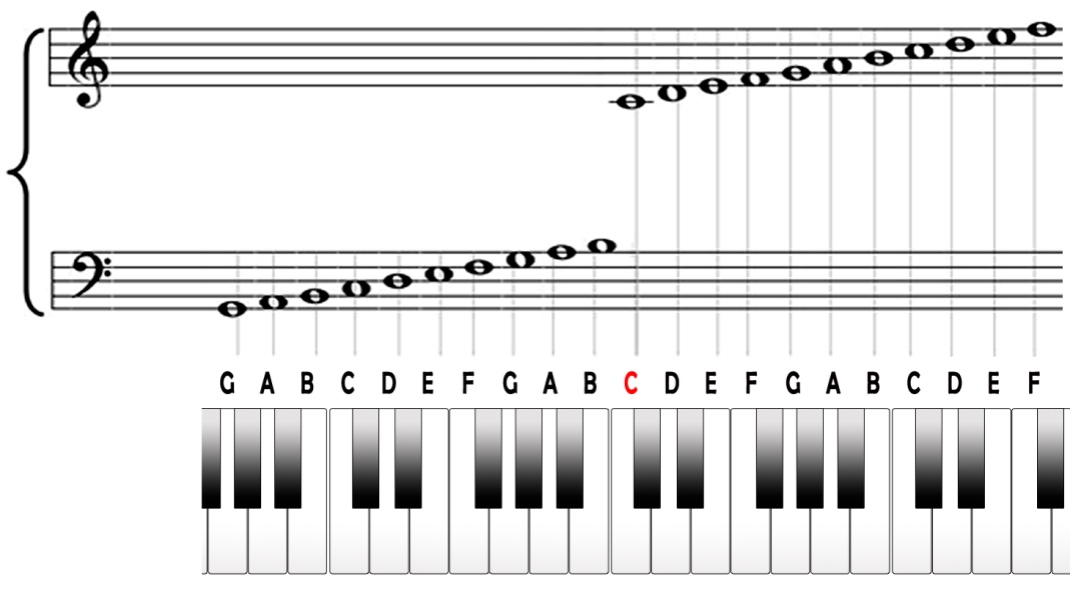 Central C belongs to the central octave on the keyboard.
Central C belongs to the central octave on the keyboard. They are represented by the following symbols, and also are their respective equal length rests. 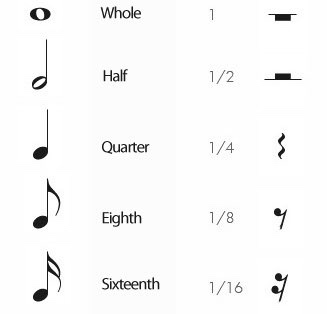 Usually time is set according to the length of certain note, commonly the quarter. Then all the other notes are related to it, so the half note is the double length of the quarter, and the eighth note is the half length of the quarter. You can easily see this relative values on the next picture.
Usually time is set according to the length of certain note, commonly the quarter. Then all the other notes are related to it, so the half note is the double length of the quarter, and the eighth note is the half length of the quarter. You can easily see this relative values on the next picture. 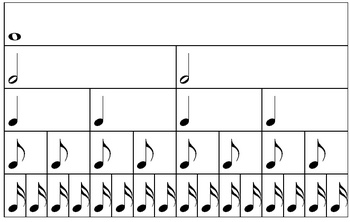 A Metronome is used to measure speed, usually the quarter note is set from 40 to 200 beats per minute (bpm).
A Metronome is used to measure speed, usually the quarter note is set from 40 to 200 beats per minute (bpm).
Commonly used are 2, 3, 4, 6, 8, 9 and 12 beats bars. Depending on how many beats the bar is composed you must count in your head, perfectly regular and uniform. Lets say you have a 4 beats bar, then you must count up to 4 and the start again. 1, 2, 3, 4, 1, 2, 3 Bars are indicated by a vertical line (bar line):  The time signature is the number you see above. Its a rational number in which the numerator (the number above) indicates the beats, and the denominator (the number below) indicates that the time is set according to the quarter note. Lesson 1- Fingering
The time signature is the number you see above. Its a rational number in which the numerator (the number above) indicates the beats, and the denominator (the number below) indicates that the time is set according to the quarter note. Lesson 1- Fingering
This first lesson is about some basic concepts regarding to the execution of the piano and its fingering.
For the piano study we will number fingers this way: Thumb = 1
Index = 2
Middle = 3
Ring = 4
Pinky = 5 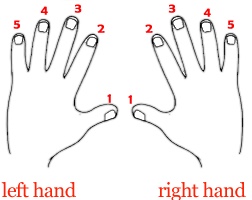
Exercise 1 - Track 01 For this exercise we will use both hands. For the F-Clef (Left hand) we will cover notes from F to B. For the G-Clef we will cover notes from C to G. Fingering is also expressed within the staff as well as the time signature. Remember, always keep counting the beats in your head, or use a metronome, which is even better. 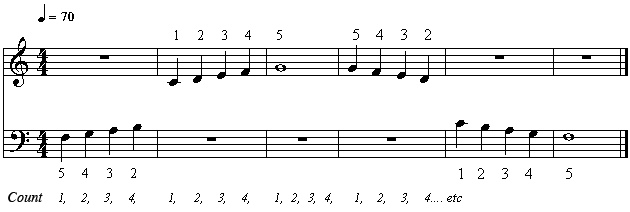 Exercise 2 Track 02 This exercise is for the right hand.
Exercise 2 Track 02 This exercise is for the right hand.  Exercise 2 Track 02 This exercise is for the right hand.
Exercise 2 Track 02 This exercise is for the right hand.
Use the same position than the exercise before.  Exercise 3 - Track 03 Now an equivalent exercise for the left hand.
Exercise 3 - Track 03 Now an equivalent exercise for the left hand.  Exercise 4 - Track 04 In this exercise we combine left and right hand. Keep the same position and fingering.
Exercise 4 - Track 04 In this exercise we combine left and right hand. Keep the same position and fingering. 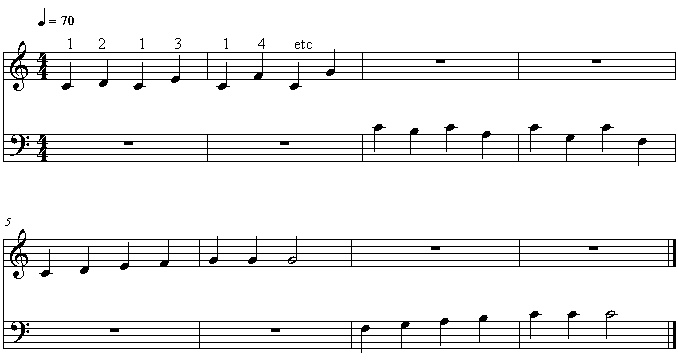
 The following exercises are meant to develop independence in both hands, thats why we will use alternatively quarters and eights on each hand.
The following exercises are meant to develop independence in both hands, thats why we will use alternatively quarters and eights on each hand. To lower the difficulty try to practice each hand separately, then, when ready play with both hands. Exercise 5 - Track 05  Exercise 6 - Track 06
Exercise 6 - Track 06 
Font size:
Interval:
Bookmark:
Similar books «Basic Piano»
Look at similar books to Basic Piano. We have selected literature similar in name and meaning in the hope of providing readers with more options to find new, interesting, not yet read works.
Discussion, reviews of the book Basic Piano and just readers' own opinions. Leave your comments, write what you think about the work, its meaning or the main characters. Specify what exactly you liked and what you didn't like, and why you think so.







